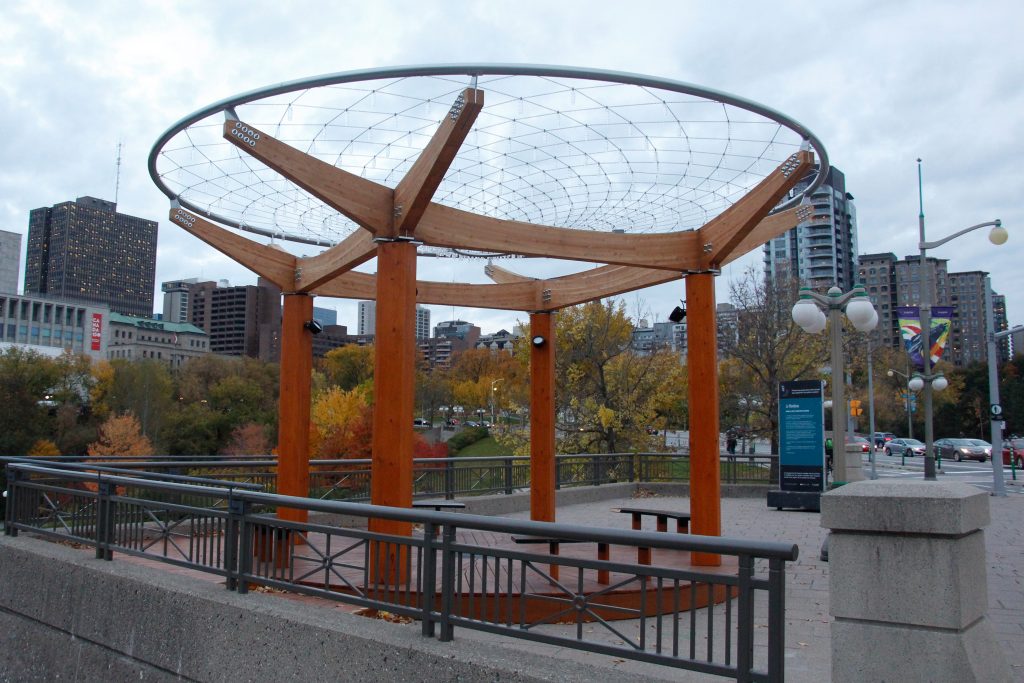Canada 150 public art to be displayed into 2018
By Floriane Bonneville
Manuel Báez and a team of artists and architects who created the public art piece The Gather-Ring went beyond the celebration of Canada 150. As Báez says, the milestone is controversial and he wants the downtown structure to make the public think beyond the 150 years of the creation of Canada.
Inspired by the design of dream catchers, The Gather-Ring has been erected at the Portage Bridge Plaza and will be there until July 2018. The site is in close proximity with Victoria Island — one of the most historically significant gathering sites in the capital region, where Algonquin and other Indigenous people met for thousands of years near the sacred Chaudière Falls.
To this day, Victoria Island is a gathering site for Indigenous peoples who often hold protests, events and celebrations there.
Báez, a Carleton University architecture professor, worked on the structure with artist Charlynne LaFontaine and Carleton students Sami Karimi, Guillermo Bourget Morales and Josh Eckert.
Báez said the structure is an opportunity for people to “discuss what was here before 1867,” as well as to think about “what the future can be in terms of getting along.”
“It’s an important time to gather and discuss history,” said Báez. “It’s not about one side or the other. If we’re serious about reconciliation, we have to communicate and talk about the good things and the bad things in the past.”
Báez was born in the Dominican Republic, grew up in New York City, and his background is a mix of Latin American and Indigenous cultures. Initially, issues were raised about the potential cultural appropriation involved in the artwork, but the architect’s personal connection to the Indigenous symbols have underscored its authenticity.
In addition, members of the Maniwaki-area Kitigan Zibi community were involved in supporting the project, which sits on unceded Indigenous territory.
Kitigan Zibi Anishinabeg Elder Verna McGregor explained that The Gather-Ring is also symbolic for her First Nation, because the surrounding area is where the Gatineau and Ottawa rivers meet, coming and flowing from the symbolic four cardinal directions. Symbolically, the benches on The Gather-Ring are placed at the corners of those four directions. McGregor mentions that the newcomers who reached the region came along the rivers.
McGregor said there is a lack of Indigenous symbolism in Ottawa, specifically Algonquin symbolism, but that the city is working to address that. At the artwork’s inauguration, federal Heritage Minister Mélanie Joly spoke about Canada 150 as a time to celebrate Canada’s extraordinary artists.
“As we celebrate this exciting milestone, public art exhibits like these provide visitors of all ages with an opportunity to discover these beautiful pieces and open their eyes to new ideas and perspectives,” she said.
The Gather-Ring was unveiled in August at the south end of the bridge west of Parliament Hill after the Báez-led team was awarded the commission under the Canadian Heritage public art program “Art in the Capital.” The program aims to showcase artistic achievements from all over Canada and celebrate the country’s diversity. This year’s theme was Dreams.
The design of the piece is meant to invoke Canada’s history. The structure and materials were curated to symbolize both Indigenous and non-Indigenous Canadian culture. The artwork is inspired by trees and dream catchers, as well as circles.
From afar, the piece looks like a pavilion: four pillars support canoe-shaped beams upon which a large dream catcher rests. The dream catcher is woven with metal wires from which delicate glass pendants hang. The pillars, the metaphoric trees, stand on a circular wooden base, and in its centre is a black, circular piece of granite.
On the wooden base are four beautiful wooden benches, which invite visitors to sit down, to reflect and discuss.
The artwork is illuminated by LED lights at night, adding to the mystical ambience of the piece. “The dream catcher’s illuminated glass at night points towards the universe, the sky — a reminder that we’re all connected in this web of life,” said McGregor.
At the website thegather-ring.ca, Báez writes that trees are stewards and symbols of our history, desires, collective memory and dreams: “Within their inner structure, their annual growth rings serve as carriers and record keepers of the land.” McGregor said that the outer rings of the structure’s base are an allegory for the years that the newcomers have spent on this land; and that the rings further away symbolize the direction where reconciliation is going to go.
The Gather-Ring is made out of eastern white pine recovered from the Ottawa River, Douglas firs from B.C., red cedar, and a circular polished black piece of Canadian granite carved like a turtle shell— echoing the name given to North America by First Nations: Turtle Island. The granite turtle shell is divided into 13 sections, representing Canada’s 13 provinces and territories.
McGregor said one of the reasons why she likes The Gather-Ring so much is because it looks aesthetically pleasing. Amidst the Portage Bridge Plaza’s grey concrete, she said the deep, warm colour of the wood reminds us that a connection to nature is more important than ever before —especially in a time when we need to think about climate change.

